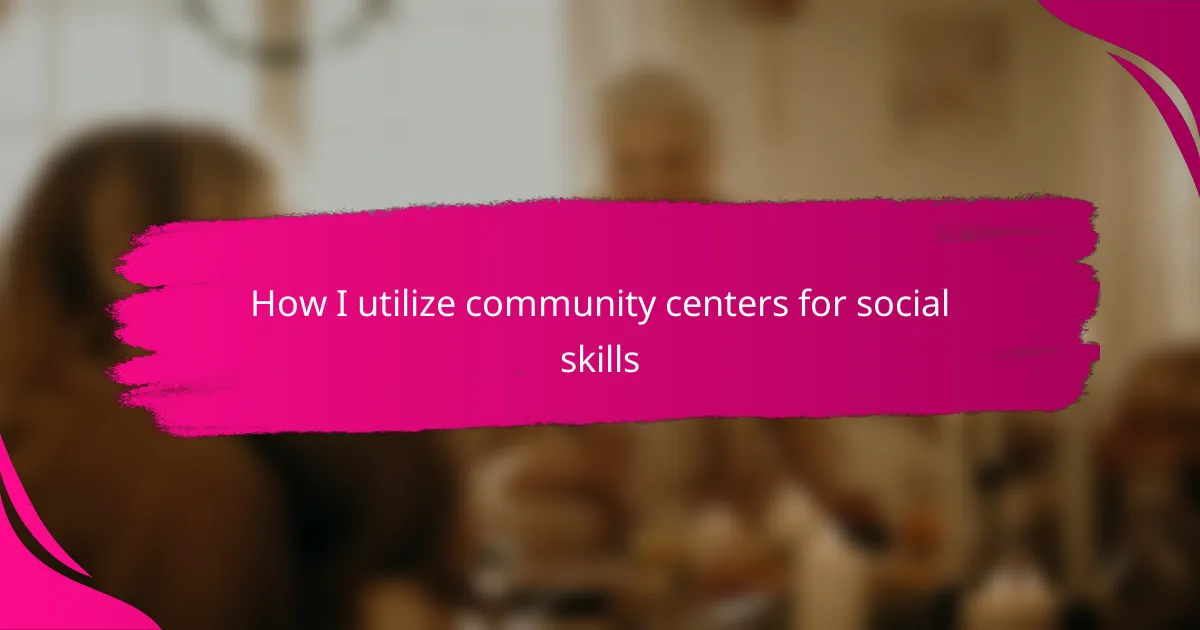Key takeaways
- Community centers serve as vital spaces for children to develop social skills through informal interactions and a variety of activities.
- Choosing activities that align with children’s interests fosters confidence and encourages social connections, making them feel at home.
- Flexibility in engagement allows children to explore different interests without pressure, promoting positive social experiences.
- Monitoring social progress and sharing experiences with other parents fosters encouragement and enhances understanding of child development.
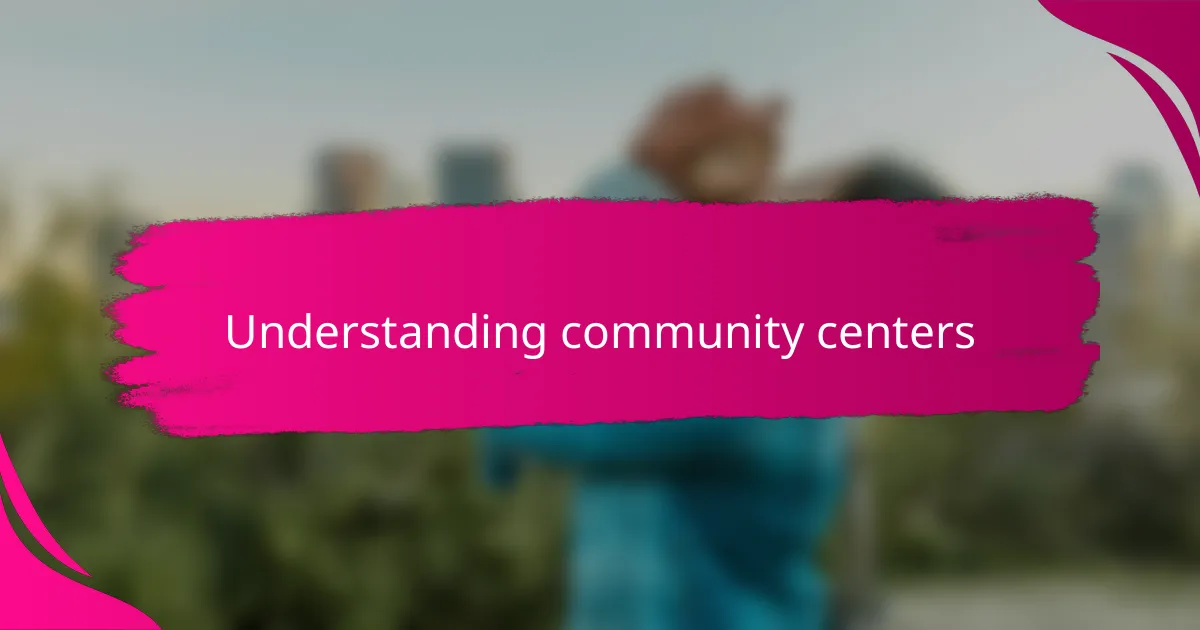
Understanding community centers
Community centers are more than just buildings; they’re vibrant spaces where people of all ages come together to learn, share, and grow. When I first stepped into our local center, I was struck by the diversity of activities and the warmth of the community, which instantly felt like a second home for my child and me. Have you ever noticed how these centers create a natural environment for social interaction without the pressure that sometimes comes with organized classes?
What fascinates me is how community centers offer both structured programs and informal gatherings, providing a flexible setting that adapts to the needs of every family. From my experience, this balance is crucial—it allows kids to develop social skills through guided play and spontaneous conversations, all under one roof. Isn’t it amazing how such places nurture connections that extend beyond just scheduled sessions?
Understanding these centers means appreciating their role as a bridge between families and the broader community. They’re not just spaces; they’re catalysts for building confidence, empathy, and communication skills in children. Reflecting on our time there, I realize it’s these subtle, everyday interactions that often have the most profound impact on social development.
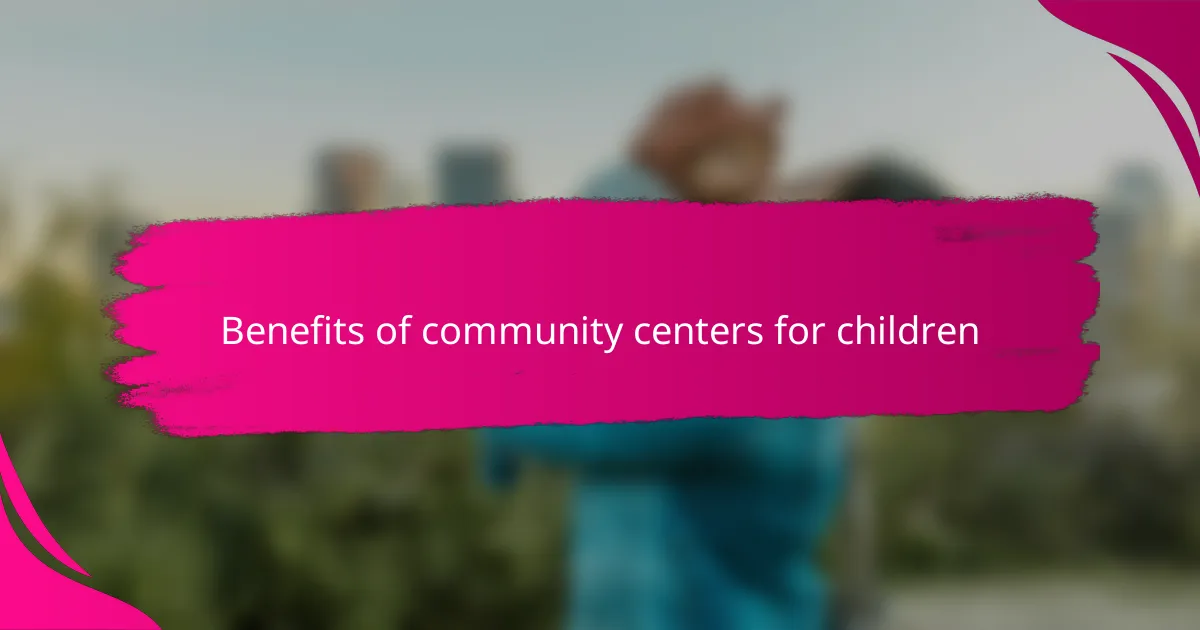
Benefits of community centers for children
One of the biggest benefits I’ve seen is how community centers create a safe space where children can practice social skills naturally. When my child started attending, I noticed they became more confident initiating conversations, simply because the environment felt welcoming and pressure-free. Isn’t it wonderful when kids learn by just being themselves around others?
Another aspect I truly appreciate is the variety of activities available, allowing children to find their niche and connect with peers who share similar interests. I’ve watched shy kids bloom during art classes or team sports, discovering a sense of belonging that might be harder to find elsewhere. These shared experiences often turn into lasting friendships, which I believe are essential for healthy social growth.
Moreover, the informal nature of community centers encourages spontaneous interactions that aren’t always possible in more structured settings. From casual chats over snacks to impromptu games, these moments teach kids important lessons about empathy, cooperation, and communication. Have you ever noticed how some of the best social lessons come from unplanned play rather than scripted activities? I certainly have, and it’s something I deeply value about community centers.
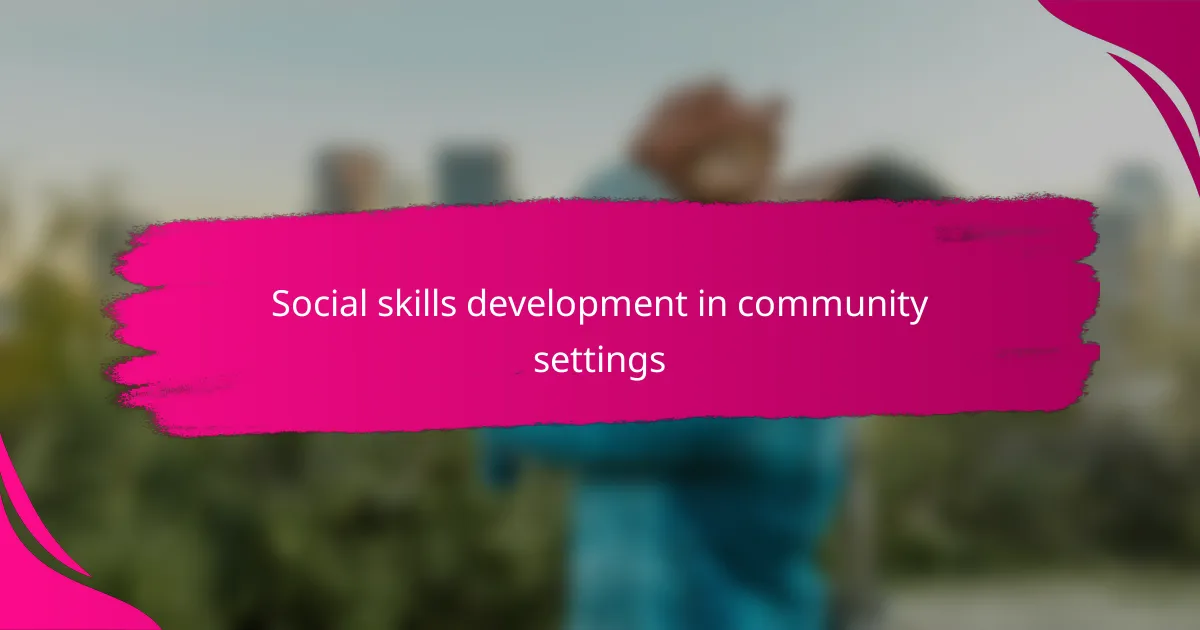
Social skills development in community settings
Spending time at community centers has shown me just how powerful these environments are for developing social skills. I’ve observed my child learn to take turns, listen actively, and express themselves clearly, simply by interacting with others in everyday situations. Isn’t it remarkable how these small, consistent interactions build the foundation for effective communication?
What stands out most to me is the sense of belonging children experience in these settings. Watching my child grow comfortable in a diverse group, navigate different personalities, and resolve minor conflicts has been truly rewarding. Have you ever noticed how practicing empathy and patience feels more genuine when it happens naturally among peers rather than in a formal classroom?
The beauty of community centers lies in their ability to blend guided activities with free play, giving kids the freedom to experiment with social roles. From planning a game to negotiating rules, my child has learned skills that no worksheet could teach. It makes me wonder—how often do we overlook the value of these organic moments in favor of more rigid learning methods?
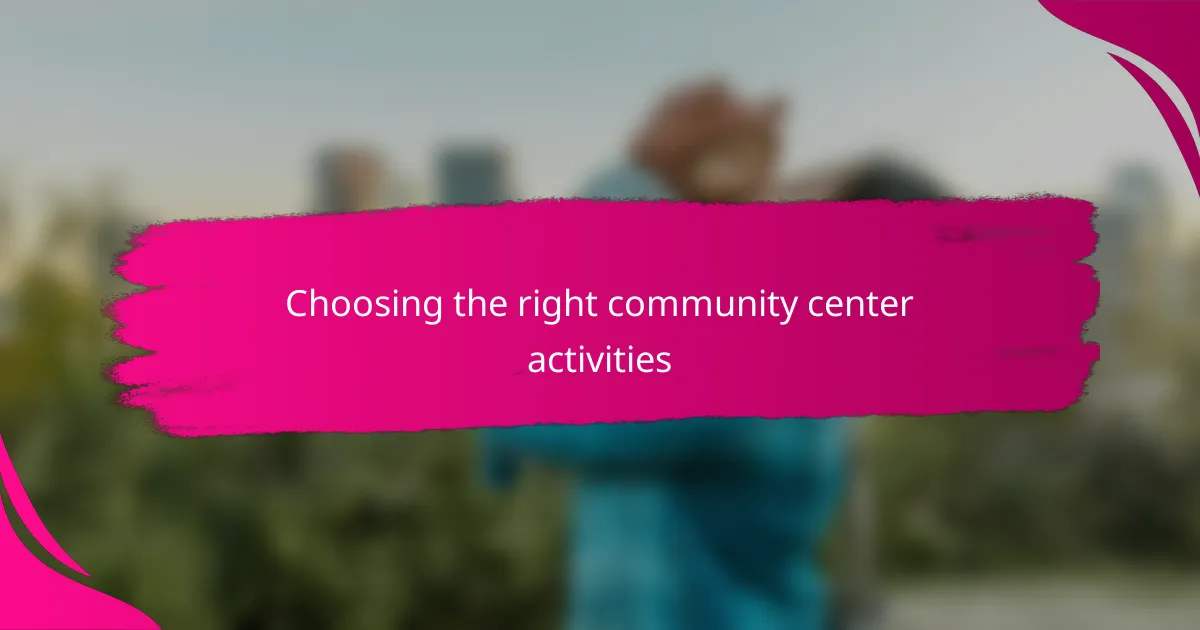
Choosing the right community center activities
Selecting activities at the community center that truly resonate with your child’s interests has made all the difference in my experience. When my child joined a drama club there, not only did their social confidence soar, but I also saw a genuine excitement to engage with new friends. Have you ever noticed how a child’s enthusiasm can reveal the perfect social setting for them?
I’ve learned that it’s crucial to balance structured and unstructured activities when choosing what to try. Some kids thrive in team sports where cooperation and communication are essential, while others prefer quieter art classes that encourage personal expression alongside subtle social interaction. How do you find the right mix for your child’s unique personality?
What surprises me most is how flexibility plays a role; if my child isn’t enjoying one activity, it’s easy to switch to another without pressure. This adaptability helps avoid social anxiety and keeps the experience positive, turning the community center into a space they actually look forward to visiting. Have you tried encouraging your child to explore multiple activities to find their best fit?
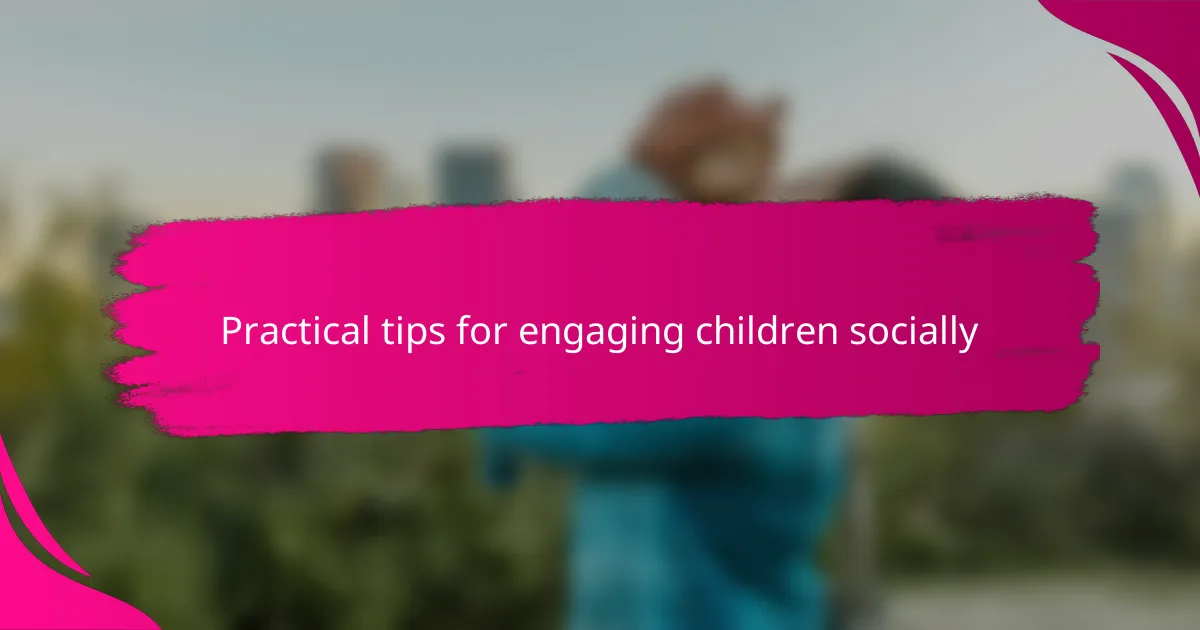
Practical tips for engaging children socially
One approach I’ve found effective is encouraging my child to initiate small conversations during community events, like asking about a game or complimenting a drawing. These simple interactions might seem minor, but they build confidence and teach kids how to break the ice naturally. Have you ever noticed how a genuine question or comment can open the door to a new friendship?
It also helps to model positive social behavior myself. When I join in on group activities or share stories with other parents and children, my child observes how to listen actively and respond empathetically. This shared experience creates a comfortable atmosphere, making it easier for kids to practice those skills without feeling self-conscious.
Last but not least, I always remind my child that it’s okay to make mistakes or feel shy at first. Socializing is a skill that grows with time and patience. When they hesitated to join a new group, I encouraged them gently, celebrating every small step forward. Doesn’t it feel rewarding to witness that gradual blossoming of social ease?
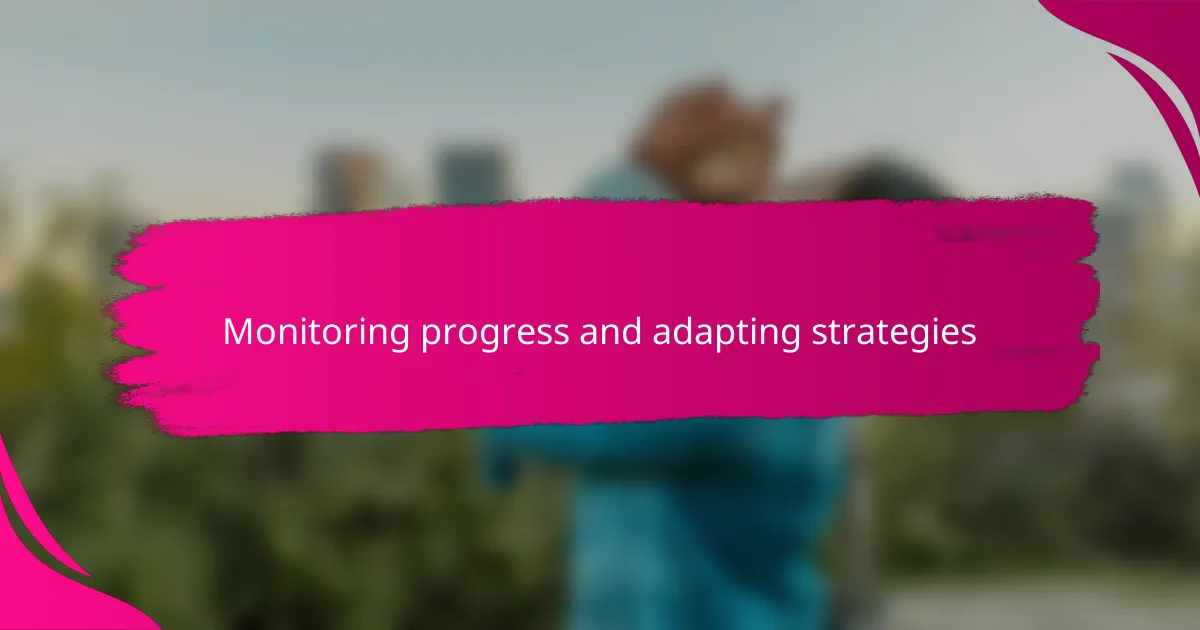
Monitoring progress and adapting strategies
Tracking my child’s social progress at the community center has been a revealing journey. I keep an eye on small changes—like how they handle disagreements or start conversations—and these moments tell me if our approach is working. Have you ever caught yourself smiling because your child tried something new in a social setting without hesitation? That, to me, is an encouraging sign.
Sometimes, what worked last month needs tweaking the next; social growth isn’t a straight line. I’ve learned to be flexible, switching from group activities to more one-on-one interactions when my child needs a gentler push. This adaptability keeps things positive and keeps their confidence growing rather than feeling overwhelmed.
What really helps is reflecting together after visits—asking gentle questions about what they enjoyed or found tricky. These conversations show me where to adjust our efforts and make sure the experience stays both fun and effective. Have you tried this kind of check-in? It’s amazing how these little talks deepen understanding and motivation.

Sharing success stories and challenges
Sharing both successes and setbacks has been an eye-opening part of our community center journey. I remember a moment when my child proudly told me about making a new friend after weeks of shy glances—those small victories felt like giant leaps. Have you experienced that surge of joy when you witness your child overcoming their social fears, even if just a bit?
Of course, challenges have surfaced too. There was a time when my child struggled to join group activities, feeling left out despite the welcoming atmosphere. It made me realize that growth isn’t always linear and that patience is key; sometimes support means stepping back and letting them find their own pace. Doesn’t it comfort you to know that setbacks don’t erase progress but rather shape resilience?
What I cherish most is how sharing these stories with other parents creates a sense of solidarity. Hearing about their struggles and triumphs has reminded me I’m not alone on this path, and together, we find encouragement and practical ideas. Have you found that exchanging experiences can turn uncertainties into shared wisdom?
